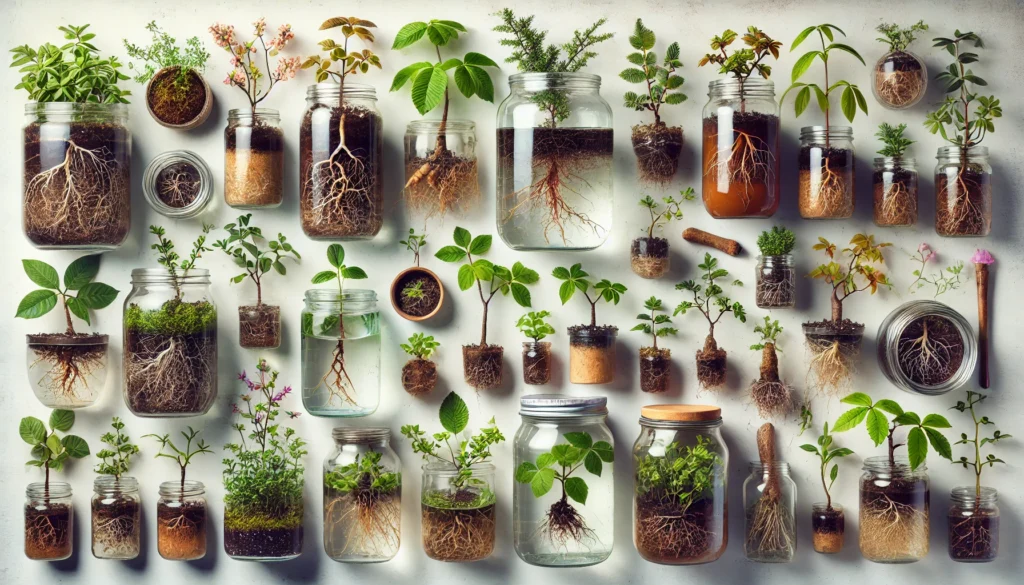
Best Time to Take Cuttings: Timing Tips for Healthy Plant Growth
Propagating plants from cuttings is one of the easiest and most rewarding ways to expand your garden, but timing plays a crucial role in success. Knowing the best time to take cuttings ensures that your plants root quickly and grow into strong, healthy specimens. Whether you’re a beginner or an experienced gardener, understanding seasonal timing and plant growth cycles can significantly improve your propagation success rate. In this guide, we’ll explore the ideal times to take cuttings, which plants respond best to different seasons, and expert tips to maximize your results. Let’s dive into the world of plant propagation!
Table of Contents
ToggleUnderstanding Plant Growth Cycles
To successfully grow and care for plants, it’s essential to understand their growth cycles. Every plant follows a natural pattern of development, moving through key stages that impact its health, flowering, and reproduction.
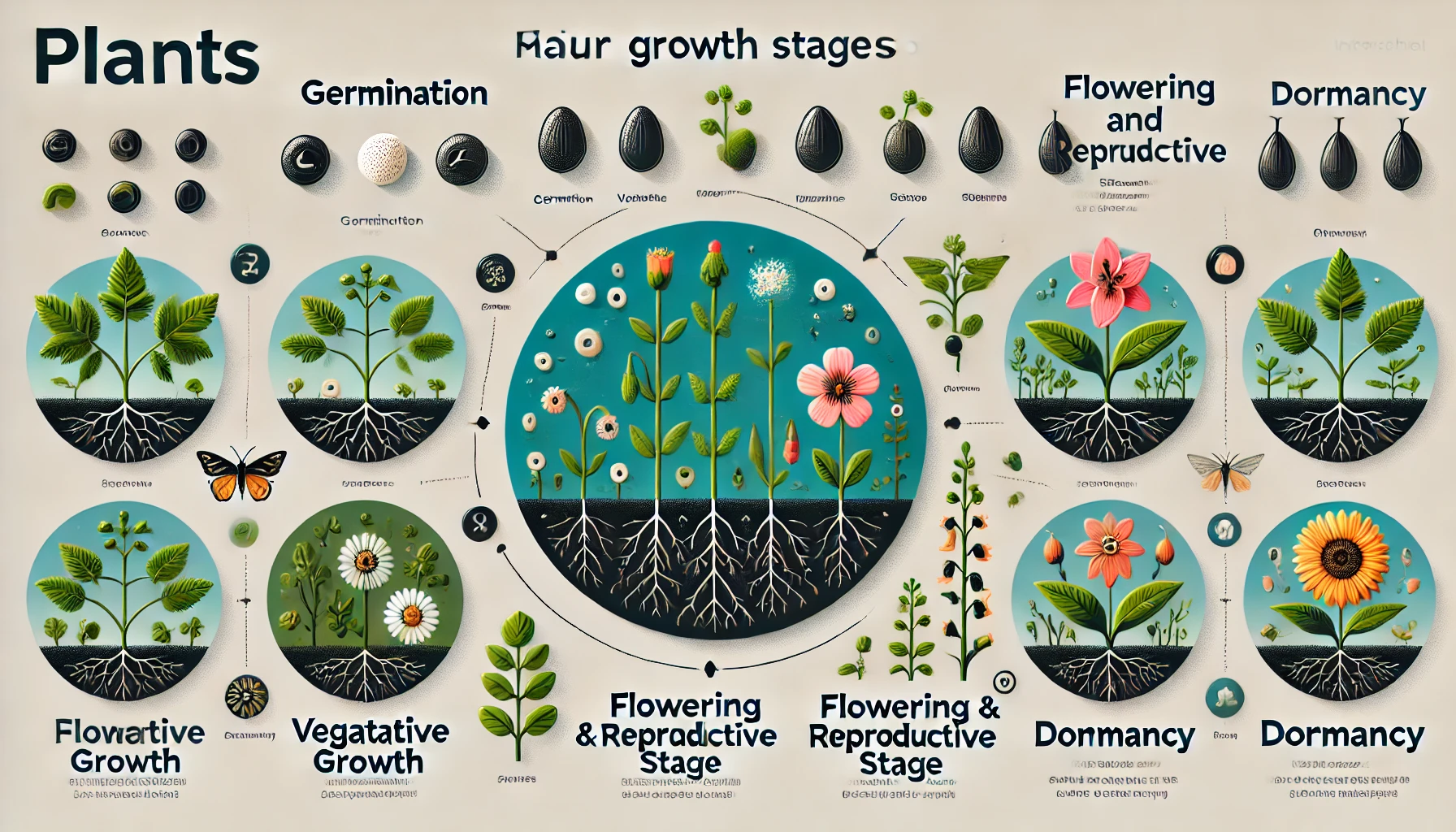
The Four Main Growth Stages
- Germination (Seed Stage)
- This is when a seed begins to sprout.
- It requires moisture, warmth, and oxygen to trigger root and shoot growth.
- Some seeds need special conditions like scarification (scratching the seed coat) or stratification (cold treatment) to break dormancy.
- Vegetative Growth
- This is when plants focus on growing strong roots, stems, and leaves.
- They need plenty of light, water, and nutrients (especially nitrogen) to build a solid structure.
- This stage is crucial for setting the foundation for flowering and fruiting.
- Flowering and Reproductive Stage
- The plant starts producing flowers, which later develop into fruits or seeds.
- It requires balanced nutrients, particularly phosphorus and potassium, to support bloom formation.
- Pollination (by wind, insects, or manual assistance) is often necessary for fruit or seed production.
- Dormancy or Senescence
- Some plants enter a resting phase, slowing down or stopping growth.
- This is common in deciduous trees, perennial plants, and bulbs during colder months.
- Proper care, like reducing watering and fertilization, helps plants survive this phase and prepare for the next growth cycle.
Why Understanding Growth Cycles Matters
- Helps in timing watering, fertilizing, and pruning for best results.
- Ensures proper propagation by selecting cuttings at the right stage.
- Supports better yield in flowering and fruiting plants by providing nutrients when needed.
- Prevents overwatering or stressing plants by recognizing natural dormancy.
By knowing how plants grow, you can create the best conditions for strong, healthy development at every stage.
Best Seasons for Taking Cuttings
Choosing the right season to take cuttings is crucial for successful propagation. The best time depends on the plant type, but generally, the ideal seasons are:
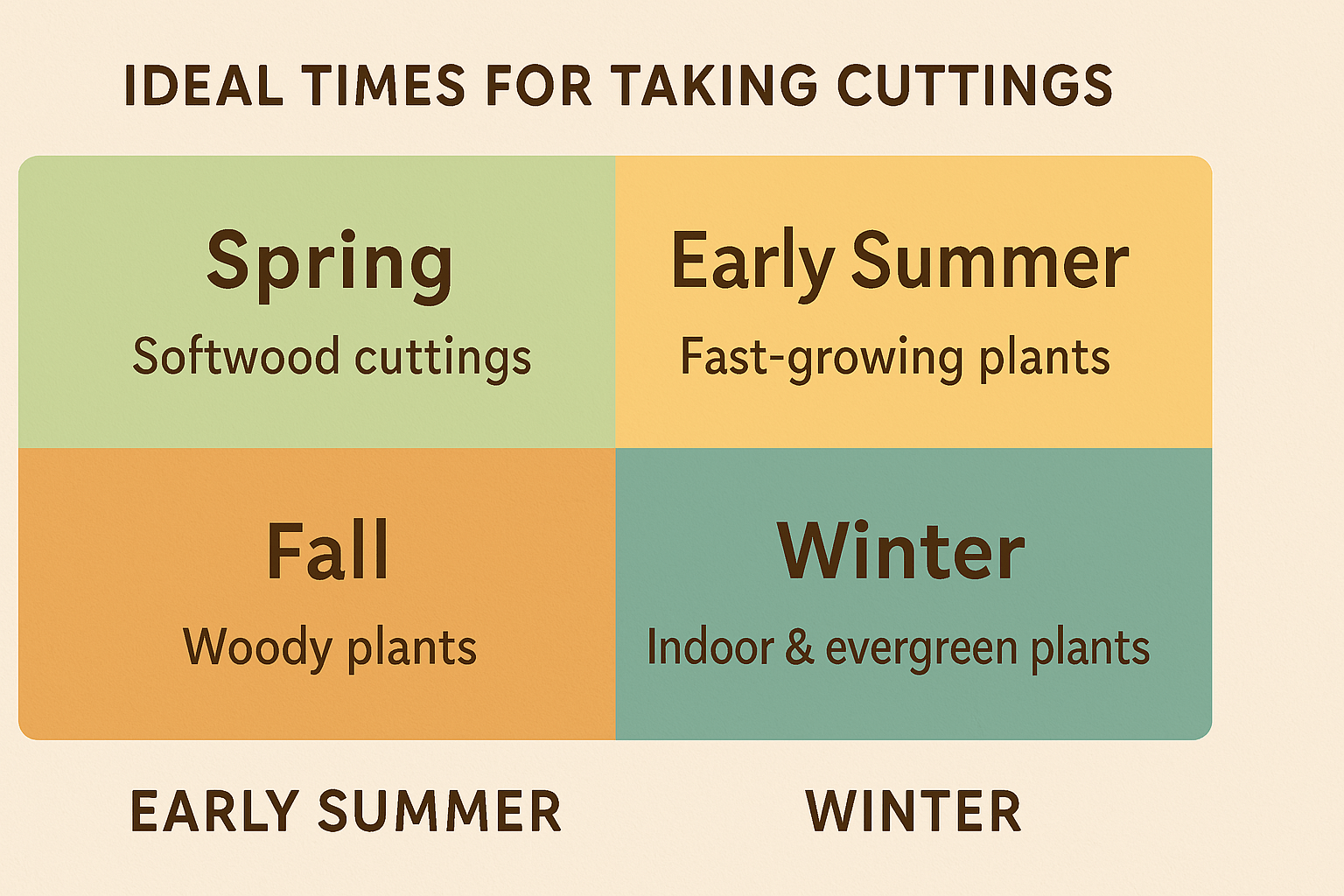
Spring – The Best Time for Most Plants
Spring is the top season for taking cuttings because plants are actively growing. New growth is tender and full of energy, making it easier for cuttings to develop strong roots. Softwood cuttings, such as herbs, perennials, and flowering plants, thrive when taken in spring.
Summer – Great for Fast-Growing Plants
Early summer is also a good time, especially for plants that grow quickly. However, avoid taking cuttings in extreme heat, as high temperatures can cause stress and dehydration. Keep cuttings in a shaded, humid environment to prevent drying out.
Fall – Suitable for Woody Plants
For shrubs and trees, fall is a good season for hardwood cuttings. Many woody plants enter dormancy, allowing cuttings to focus on root development instead of leaf growth. Just ensure they are kept in a cool but frost-free environment.
Winter – Less Ideal but Possible
Winter is usually not the best time for propagation, as most plants are dormant. However, some indoor plants and evergreens can still be propagated if given warmth and adequate light.
By timing your cuttings correctly, you increase the chances of successful rooting and healthier new plants. Always check the specific needs of each plant for the best results.
Best Time of Day to Take Cuttings
Timing plays a crucial role in successful plant propagation. Taking cuttings at the right time of day increases the chances of strong root development and overall plant health.
Early Morning is Best
The ideal time to take cuttings is early in the morning when plants are fully hydrated. Overnight, plants absorb moisture, making their stems firm and full of nutrients. This helps cuttings stay fresh longer and reduces the risk of wilting.

Avoid the Hottest Part of the Day
Midday heat can cause plants to lose moisture quickly. Taking cuttings during this time increases stress and decreases the chances of successful rooting. If you must take cuttings later in the day, choose a cool, shaded area.
Cloudy Days are a Bonus
If possible, take cuttings on a cloudy day or when temperatures are mild. This helps minimize moisture loss and stress, giving the cutting a better start in its new environment.
By choosing the right time, you ensure your cuttings are strong, hydrated, and ready to develop healthy roots quickly.
Factors That Influence the Success of Cuttings
Successful propagation depends on several key factors that directly impact root development and overall plant health. Understanding these elements will help you achieve the best results.
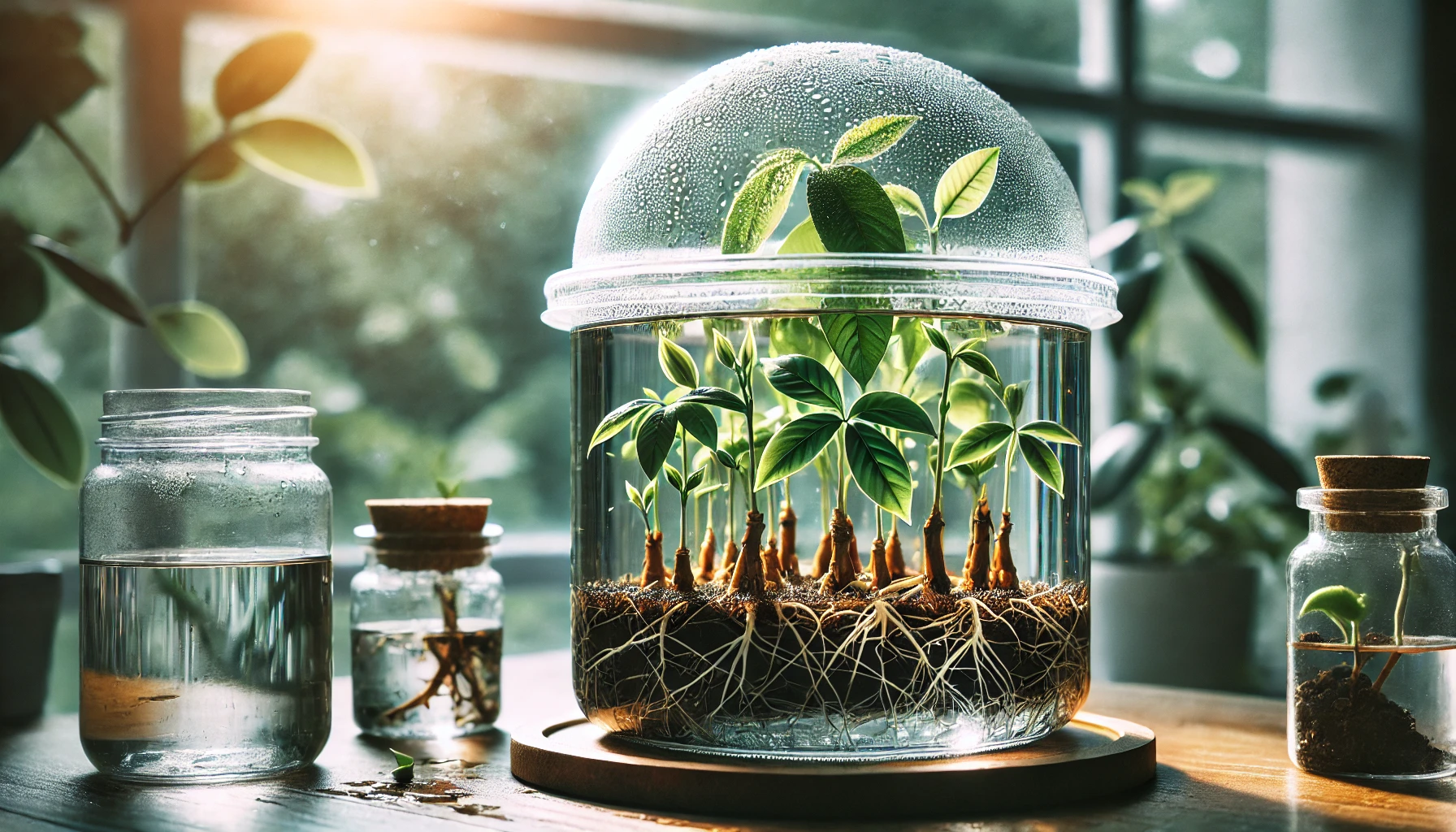
Plant Selection
Not all plants propagate easily in water. Soft-stemmed plants like pothos, philodendron, and coleus root faster, while woody stems may struggle. Choose healthy, disease-free cuttings for the best success.
Cutting Technique
A proper cutting increases the chances of rooting. Use clean, sharp scissors or pruning shears to make a diagonal cut just below a leaf node. Removing excess leaves prevents energy loss and focuses growth on root development.
Water Quality
Fresh, clean water is essential. Chlorinated tap water can slow root growth, so use filtered or dechlorinated water. Change the water every 2-3 days to prevent bacteria buildup and oxygen depletion.
Light Exposure
Cuttings need bright, indirect light. Too much direct sunlight can scorch them, while low light can slow root development. A spot near a window with filtered sunlight works best.
Temperature and Humidity
Cuttings thrive in warm, humid conditions. Ideal temperatures range between 65-75°F (18-24°C). If your home is dry, consider using a humidity dome or placing the container near other plants to maintain moisture.
Rooting Hormone (Optional)
Some plants benefit from a rooting hormone to speed up growth. If using one, dip the cut end into the powder or gel before placing it in water to encourage faster root formation.
Patience and Monitoring
Propagation takes time. Regularly check for root development and remove any rotting parts. Once roots reach about 1-2 inches, transplant the cutting into soil for continued growth.
By controlling these factors, you’ll maximize your success rate and enjoy a thriving collection of new plants.
Tips for Successful Plant Propagation
Propagating plants successfully requires the right techniques and conditions. Follow these expert tips to improve your success rate and grow strong, healthy plants.
Choose Healthy Cuttings
Select cuttings from a mature, disease-free plant. Look for stems that are firm and have at least a few leaves. Weak or damaged cuttings struggle to root and grow.
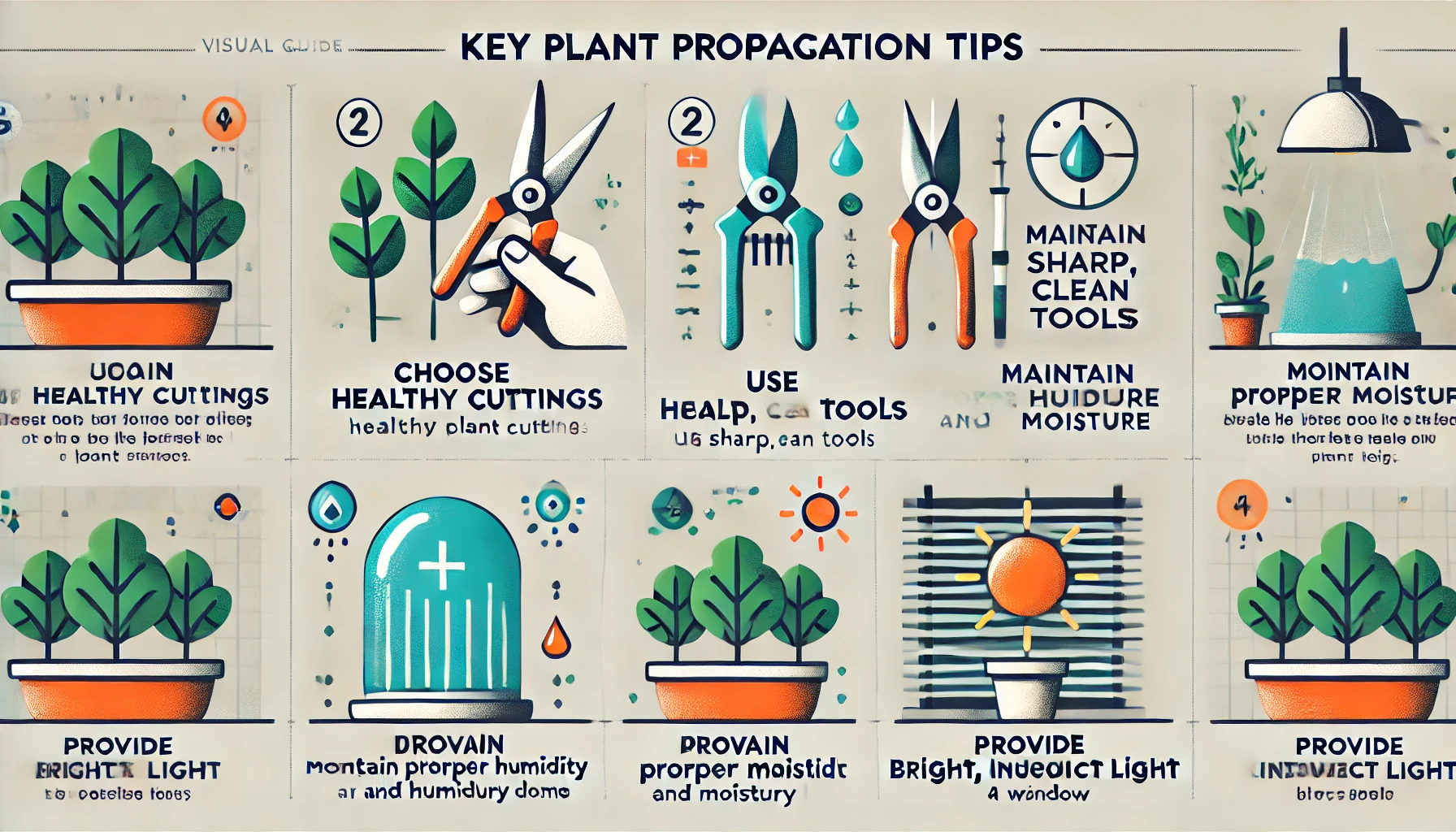
Use Sharp, Clean Tools
Always use sterilized scissors or pruning shears to make clean cuts. A jagged or crushed stem can lead to rot and slow down root development.
Pick the Right Growing Medium
Depending on the plant, propagation can be done in water, soil, or a rooting mix. Water is great for monitoring root growth, while soil or perlite provides better long-term stability.
Maintain Proper Humidity and Moisture
Keep the growing environment humid but not soggy. Cover cuttings with a plastic bag (with ventilation holes) to create a mini greenhouse effect, helping retain moisture without causing mold.
Provide Indirect Light
Bright, indirect light is ideal for root development. Avoid placing cuttings in direct sunlight, which can dehydrate them before roots form.
Change Water Regularly (for Water Propagation)
If propagating in water, change the water every 2-3 days to prevent bacteria buildup and keep the cutting healthy. Stagnant water can cause root rot.
Use Rooting Hormone (Optional)
Applying rooting hormone to the cut end of the stem can speed up root formation and improve success rates, especially for woody plants.
Be Patient and Monitor Growth
Rooting can take days to weeks, depending on the plant type. Check regularly for new growth and transplant into soil once roots are strong enough.
By following these tips, you’ll increase your chances of successful plant propagation and enjoy watching your new plants thrive!
Common Mistakes to Avoid
When propagating plants, it’s easy to make mistakes that can hinder growth. Avoid these common pitfalls to improve your chances of success:
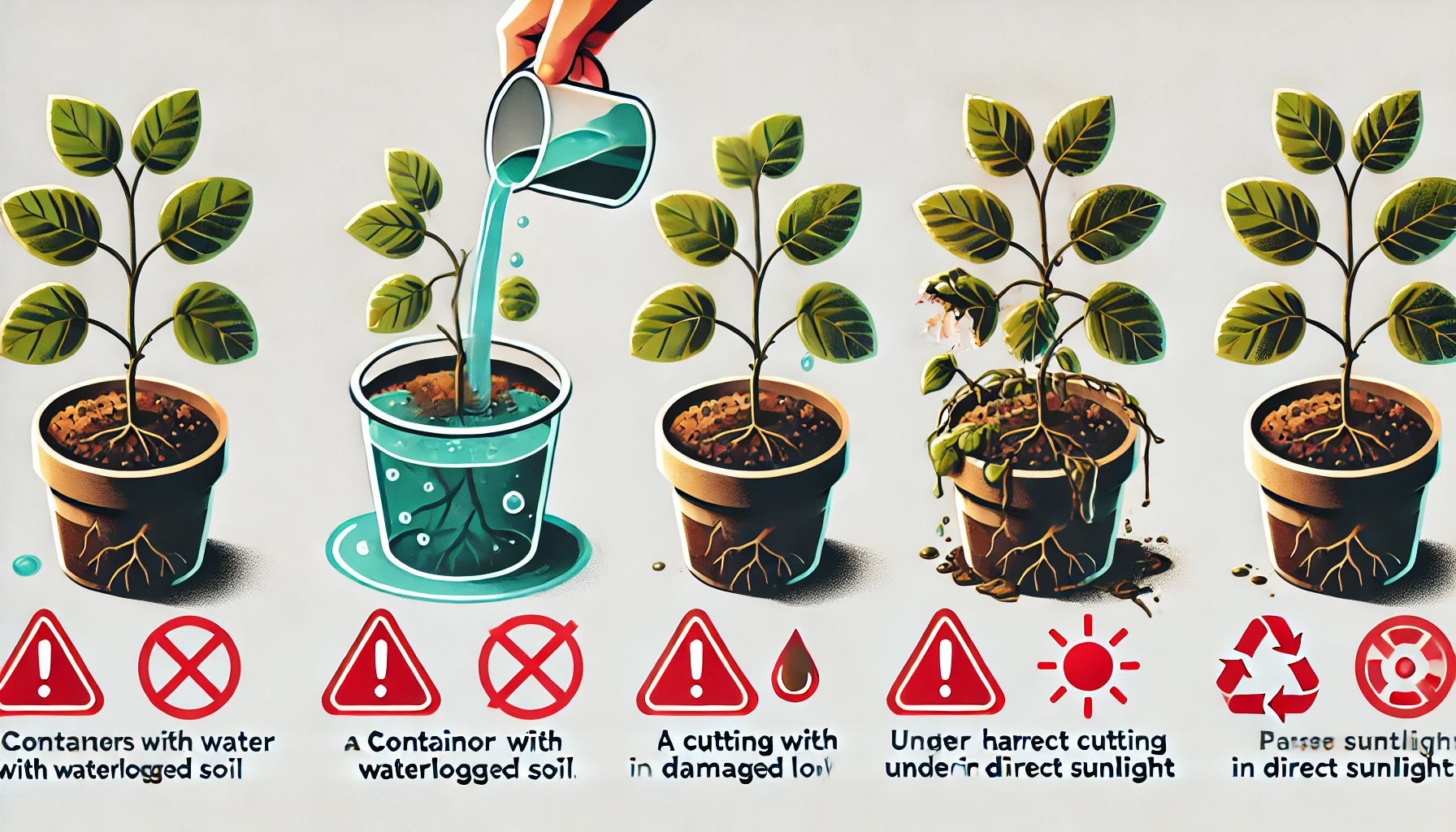
Using the Wrong Type of Cutting
Choose healthy, disease-free cuttings. Avoid using old or damaged stems, as they are less likely to root successfully. A fresh, healthy cutting from the tip or middle of the stem is ideal.
Not Preparing the Cutting Properly
Ensure you make clean cuts just below a node (where leaves meet the stem). Removing excess leaves and flowers can help focus energy on root development, reducing the chance of rot or disease.
Overwatering or Underwatering
Watering is crucial. Too much water can cause the cutting to rot, while too little water can dry it out. Keep the soil moist but not soggy, and make sure the container has proper drainage to avoid waterlogging.
Not Using Rooting Hormone
Rooting hormones can significantly improve the success rate of cuttings, especially for harder-to-propagate plants. Dip the cutting’s cut end in rooting hormone before planting it in soil or water to encourage faster root growth.
Placing the Cutting in Direct Sunlight
New cuttings are sensitive to intense sunlight. Direct exposure can lead to dehydration or stress. Place them in bright, indirect light for optimal growth conditions, and avoid extreme heat.
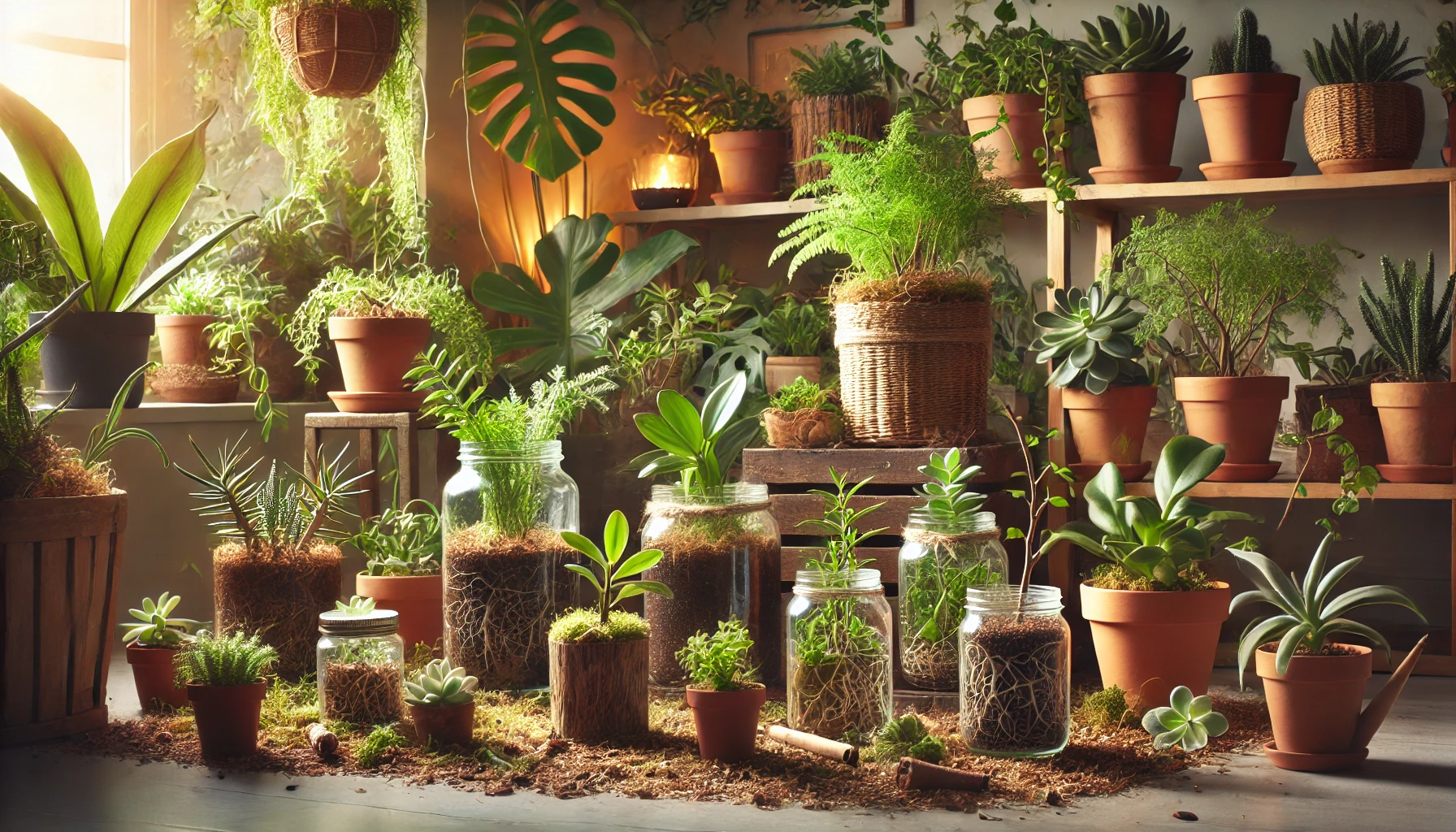
In conclusion, knowing the best time to take cuttings is essential for successful plant propagation. By aligning your cutting efforts with the right season, growth stage, and time of day, you can significantly increase the chances of your cuttings rooting and thriving. Whether you’re working with softwood in spring or hardwood in winter, understanding your plants’ needs and following the right techniques will ensure healthy, vibrant growth. Remember, plant propagation is a learning process, so don’t be discouraged by initial challenges. With patience, practice, and the tips shared in this guide, you’ll soon be able to propagate your favorite plants with confidence and grow your garden like a pro. Happy propagating!
Frequently Asked Questions(FAQ)
What is the best time to take cuttings for most plants?
The best time to take cuttings generally depends on the plant type. In most cases, spring and early summer are ideal for softwood and semi-hardwood cuttings, while fall is best for hardwood cuttings. These seasons align with plant growth cycles, providing optimal conditions for root development.
Can I take cuttings in winter?
Yes, you can take cuttings in winter, but it is usually limited to hardy plants or those that are not in their dormant phase. Indoor plants and evergreens are often good candidates for winter propagation.
Why is early morning the best time to take cuttings?
Early morning is the best time because plants are well-hydrated after the night, and the cooler temperatures reduce the risk of stress. Taking cuttings during this time gives them the best chance of rooting successfully.
Can I take cuttings from any plant at any time of the year?
Not all plants can be propagated at any time of the year. The best time to take cuttings varies with the type of plant, as they all have different growth and dormancy cycles. It’s important to understand the plant’s needs to improve success rates.
How do I know when my plant is in its active growth phase?
A plant is in its active growth phase during the spring and early summer when it is putting out new shoots or leaves. This is the ideal time for taking cuttings, as the plant is focused on growth and regeneration.
Should I use rooting hormone when taking cuttings?
Using rooting hormone is optional but can be beneficial for many types of cuttings, especially woody plants. It encourages faster root growth and can increase the chances of success, particularly if you’re propagating during less-than-ideal conditions.
Can I take cuttings from flowering plants?
Yes, but it’s usually better to wait until the plant has finished flowering. Taking cuttings during or just after the blooming period can ensure the plant is focusing on root development rather than sustaining blooms.
How long should I wait for roots to develop on my cuttings?
The time it takes for cuttings to root depends on the type of plant, but typically, it can take anywhere from 2 to 6 weeks. Ensure the cuttings are kept in appropriate conditions, such as adequate light and humidity, to encourage rooting.
